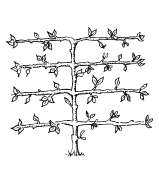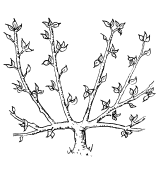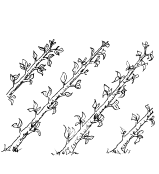BACK
Espalier

Don’t be put off by the fancy French word! People think that the process of Espaliering a tree is for horticultural Houdinis, when in fact anyone can muck around with the secateurs (there’s another French word!) and shape a tree or shrub into an Espalier. So get in touch with your inner Frenchie, and give it a go!
What you want to achieve is the creation of a "two-dimensional" or single-plane pattern made by the branches of the tree. The technique was popular in the Middle Ages in Europe to produce fruit inside the walls of a typical castle courtyard – where space was limited - and to decorate solid walls. Evidence exists suggesting that the technique dates back even further, perhaps to ancient Egypt. I wonder if Cleopatra espaliered in her spare time, when she wasn’t seducing some hot Pharaoh or other.
The word ‘espalier’ initially referred to the actual trellis on which the plant was trained to grow, but over time has come to be used to describe the technique.
An espalier collects almost as much sunlight as a regular tree, yet has far less mass. It can also be planted next to a wall, which will reflect more sunlight and retain heat overnight, or be planted so that they are facing North and can absorb maximum sunlight. These two facts allow an espalier to succeed in cooler climates, where a non-espaliered tree of the same variety would fail. They also mature their fruit more quickly.
Today, espaliered trees, ornamental and fruit producing, are grown not only against walls, but free-standing on wires, both to save space and to create screens as well. So the notion that a lot of space is required to grow fruit is no longer valid. And remember, you do not require any special skills to espalier trees, as this comes with experience. Today, espalier has evolved from a space-saving technique into an art form.
What types of fruit trees can be Espaliered?
Almost any variety of apple, pear or fig is suitable for espalier. Stone fruit (peaches, plums and cherries) are best suited to the fan-shaped espalier as their more brittle wood is difficult to train on the horizontal lines.
Locating your Espalier trees
All fruit trees require a sunny site sheltered from wind If your region is prone to spring frosts, adequate air circulation around the tree is necessary. They can be grown along walls and fences but beware of north facing iron fences as the heat reflected from these may scorch the tree.
If you do not have a wall they can be grown along a free standing fence strung with wires supported by sturdy posts which should be placed about 4-5 m apart and 2m of post above ground. 4 - 5 wires should be tightly strung between posts, with the first wire 50cm above the ground and the others at 30cm intervals. Use soft materials such as hessian, rubber, nylon stockings to tie the branches to the wires. Do not tie with wire as this can damage the branches.
Types of Espalier
There are several types of espalier, including Standard (branches grow horizontally out of one central trunk), Palmette (branches grow in a fan shaped pattern), and Cordon (the tree resembles a Candelabra). A Belgian Fence is a form of espalier that weaves a row of espaliers into a fence. There are other more elaborate shapes that are variations on the above. Each espalier pattern requires different training, but in general the light pruning and shaping is done in the autumn, the heavy pruning in the winter and the training in the summer when growth is at its peak.
Standard Espalier Training techniques

One year old trees are best, and the ideal is that they should be unbranched. If only branched trees are available, retain the straightest leader and cut away the rest. After planting, the central leader is reduced to 5 cm below the first wire and when growth occurs, only the top 3 shoots should be allowed to grow. The top shoot is then tied to an upright cane that is secured to the wires. The 2 side shoots will become the 2 lowest branches. Tie side shoots to canes at an angle of about 45 so the laterals maintain their strength of growth while training is started.
In late autumn remove the supporting canes and tie the branches to the horizontal wires. With the central stem again cut back to about 5 cm below the second wire to train the next tier. Continue every season until the tree reaches the top wire when you only retain 2 buds to tie down.
Fan Espalier training techniques
For stone fruit, the central leader is cut out, leaving 2 vigorous side shoots which are trained outwards at 30 - 45 degree angles to encourage branching. As they fruit only on 1 year old wood, there must be a continual renewal of growth to carry fruit. Fruit the lateral one year, and after harvest shorten to a side shoot near the base.

Cordon Espalier training techniques
Again 1 year old unbranched trees are best with side shoots shortened to 3 buds. If only branched trees are available, se1ect the straightest leader, cut the remaining leaders right back. Plant at the angle intended for training. In Summer, prune strong lateral shoots longer than 30 cm, cut back to 4-5 buds. In winter, prune according to growth, but leave laterals up to 10 cm uncut. Laterals 10-20 cm long should be left uncut in year 1 and the following winter shortened back to a bud on 2 year old wood. This is done to encourage year old laterals to develop fruit buds. Laterals longer than 20 cm can either be cut to 3 buds or tied down so that the tips are below the horizontal to encourage fruit buds on laterals. Following winter untie and shorten to 15 cm.

Belgian Fence Espalier training techniques
This pattern will form a very dense screen and is best used in a free standing situation. To create this, several plants are spaced 45-60cm apart. After planting, prune and train as for a horizontal cordon. When the lateral shoots form, train them at opposite 45 degree angles so that laterals from neighboring plants cross to form a diamond pattern. A plant that has been espaliered correctly is a beautiful asset to any garden or wall. It is a perfect solution for small-inner city gardens.

Once your espaliered fruit trees have been established it will require less pruning and more support as the fruit grows heavier. And you will be regarded as an Artiste!
BACK
HL Nurseries Limited t/a Wairere Nursery
826 Gordonton Road, R D 1, Hamilton 3281 Ph: (07) 824 3430 Email: